Featuring folk and outsider art from the U.S. and Canada, with an emphasis on the works of Nova Scotia artists past and present.
Don't wanna be here? Send us removal request.
Photo

Harold Weaver lived alone in a small home outside of Halifax.
For several years he had on occasion produced small carvings which he used to decorate the railings around the veranda of his home. He was discovered by folk art collector Chris Wilcox and although he agreed to sell a few pieces to Chris after several visits, most of his work did not become available until after his death in the late 1990s.
It is estimated that he carved fewer than fifty pieces in total. His work, which is very distinctive, is virtually unknown other than to a small number of collectors in Nova Scotia.
2 notes
·
View notes
Photo
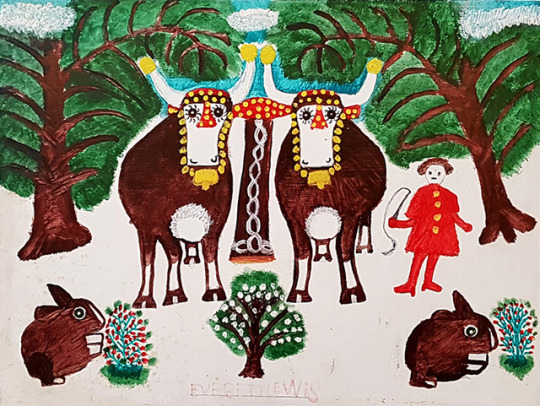
Everett Lewis painting of oxen, rabbits and Maud Lewis.
Maud Lewis movie, Maudie, is now showing in theatres in the U.S. and Canada. The movie has been reviewed by The New York Times, The Washington Post and The Globe and Mail just to name a few. Critics have praised Sally Hawkins' Oscar-worthy performance according to Robert Pius and Indiewire.
2 notes
·
View notes
Photo
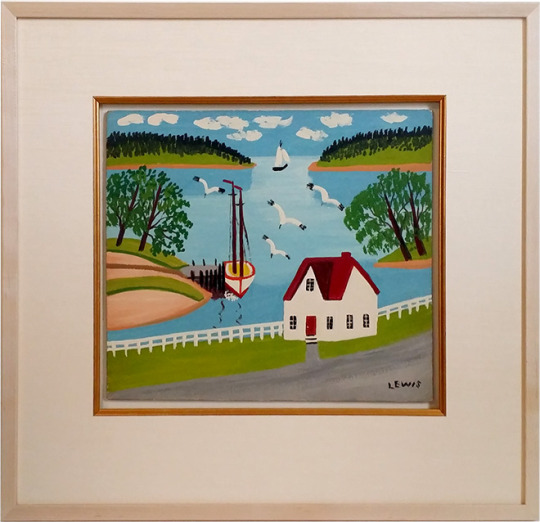

Two exceptional paintings by Maud Lewis. These paintings were purchased directly from Maud Lewis by a young man aged 17 from Digby, Nova Scotia. They were misplaced for 57 years. When his parents were downsizing their home the paintings were discovered wrapped in tissue paper and tucked in their LP collection. Both paintings are available for purchase from the Black Sheep Gallery. www.blacksheepart.com
2 notes
·
View notes
Photo
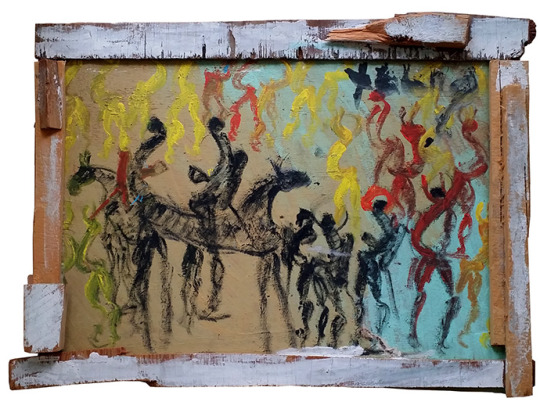
Purvis Young was born in Liberty City, Miami, on February 2, 1943. His uncle introduced him to drawing as a young boy but he lost interest. He never attended high school. He spent three years in Florida’s Raiford State Penitentiary for breaking and entering when he was a teenager. He started to draw while he was in jail. According to Young, an angel had spoken to him in prison and told him to create. He moved to Overtown after his release from prison. In the 1970s Purvis was influenced by photographs of murals he had seen such as, the Wall of Respect mural in Chicago and the Freedom Wall in Detroit, as well as from the civil rights and Vietnam protests of the sixties, and the Black Arts Movement. He nailed hundreds of paintings to the sides of the boarded up buildings that formed the Good Bread Alley, which was named after the Jamaican bakeries that once occupied the street. Many of the paintings are on materials and other debris he found throughout Overtown. From chunks of plywood and other construction materials, Young would fashion frames for his paintings. Recurring themes in his work were horses, angels, and urban landscapes. Through his works he expressed social and racial issues, and served as an outspoken activist about politics and bureaucracy Young said in an interview reprinted in his New York Times obituary “What I say is the world is getting worser; guys pushing buggies, street people not having no jobs here in Miami, drugs kill the young, and church people riding around in luxury cars.” In 2006 a feature documentary entitled Purvis of Overtown was produced about his life and work. His work is found in the collections of the American Folk Art Museum, the Corcoran Gallery of Art, the High Museum of Art, the National Museum of African American History and Culture and the Philadelphia Museum of Art, among others.
2 notes
·
View notes
Photo



The pictures above show the evolution of the articulated hands created by Nova Scotia folk artist George Munroe, which were present in his early carvings, and became more sophisticated in later pieces. The first hand shown above is very thick and flat. the fingers are short and the space between the fingers is simply a score in the wood, creating a weblike appearance. In the second example the hands are still thick, and the fingers short, and the hand is more animated but slightly distorted. The fingers themselves are now completely separated, and it can be seen that the artist is no longer sticking to the original block of wood but attempting to create a more realistic three dimensional object. In his later work, shown in the last picture, the hands are delicate with a slight bend at mid palm. The fingers are longer and more realistic, as each finger has been carved in the round and tapers to a narrow fingertip. Visit Black Sheep Gallery to see examples of George Munroe's artwork.
1 note
·
View note
Photo

Maud Lewis has included her husband Everett in this painting, Watch for the new movie about Maud Lewis which should be released in the summer of 2016. Ethan Hawke, the Oscar nominated star of Boyhood, will play Everett Lewis. He stars opposite Sally Hawkins, who played Cate Blanchett's sister in Blue Jasmine, as Maud. www.lighthouse.ca/maud.html
#Maud Lewis#ethan hawke#sally hawkins#everett lewis#folk art#Nova Scotia folk art#boyhood#blue jasmine
0 notes
Photo

Painting by folk artist Maud Lewis
1 note
·
View note
Video
dailymotion
(via Folk Art Found Me - Video Dailymotion)
0 notes
Photo
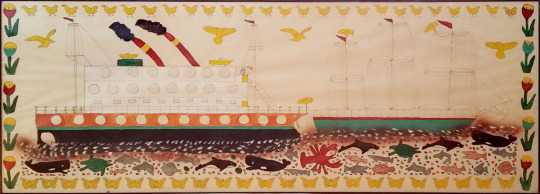
We hope you will drop by for our opening exhibition INSIDE THE LINES Joseph Sleep (1914 – 1978). One of Canada’s premier folk artists, Joe Sleep was well known for his use of templates in creating his paintings. Once he had drawn the outline of a marine creature, an animal or a bird, he would fill it in with bright colours. His fish, horses and birds painted in bright reds and yellows are reminiscent of the colourful carnival environment in which he worked for many years throughout Nova Scotia. It has been said that Joe’s “images offer a coherent life view of a kind of peaceable kingdom, a good natured world in which the elements co-exist in a perpetual tranquility”. Bernie Riordan former director of the Art Gallery of Nova Scotia and the Beaverbrook Art Gallery referred to Joe as “a man of the Maritimes who created and revealed a folk scheme of his universe in pictorial form”.
0 notes
Photo
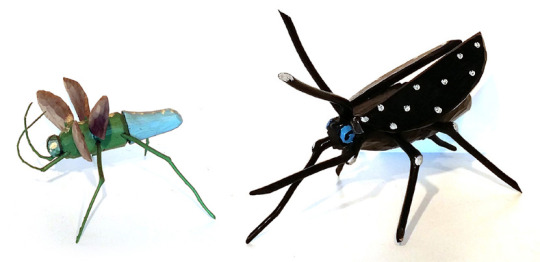
Evolution - Ransford Naugler’s insects then and now
While the basic elements of Ransford’s flying insects remain the same – carved bodies and wings with legs made from natural twig formations, the early renditions are very different from his later versions. They have evolved from delicate winged sprites painted with cool pastel blues and greens to large horsefly like creatures painted in much stronger shades of bright shiny reds, greens and sometimes even black, with the addition of somewhat menacing contrasting colour dots.
http://www.blacksheepart.com/ransford.html
0 notes
Photo
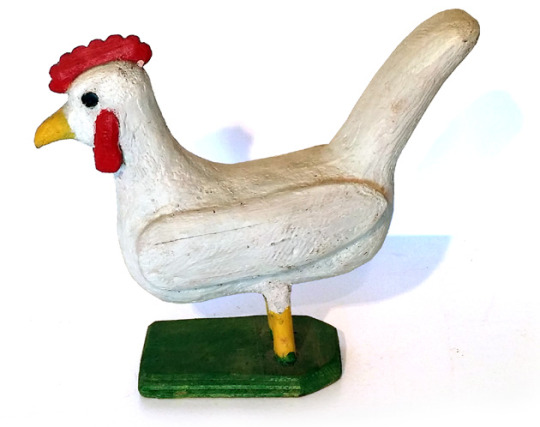
Spunky little rooster by Ewald Rentz from the collection of Karen and Werner Gundersheimer. Ewald Rentz was born in North Dakota in 1908. He grew up on a farm in Manitoba with his five brothers and three sisters. Rentz apprenticed as a barber in Winnipeg and later moved to northern Ontario where he worked in the logging camps and as a prospector.
During his work as a prospector Rentz found unusual roots, branches and fungus. In his spare time he would coax the hidden forms out of the wood and fungus and turn them into sculptures. He used plastic wood and paint to finish the pieces. Ewald Rentz created a variety of whimsical and often humorous people and animals including bellhops, matadors, and turkeys.
His work can be found in the Canadian Museum Of Civilization permanent collection and many collection across North America.
Ref: Canadian Museum of Civilization, Just for Nice; German-Canadian Folk Art (1993); Kobayashi/Bird, A Compendium of Canadian Folk Artists (1985); Blake McKendry, Folk Art Primitive and Naïve Art in Canada (1983): Blake McKendry, An Illustrated Companion to Canadian Folk Art (1999): Bernard Riordon (Beaverbrook Gallery), Canadian Folk Art from the Collection of Susan A. Murray (2007).
www.blacksheepart.com/rentz4.html
1 note
·
View note
Photo
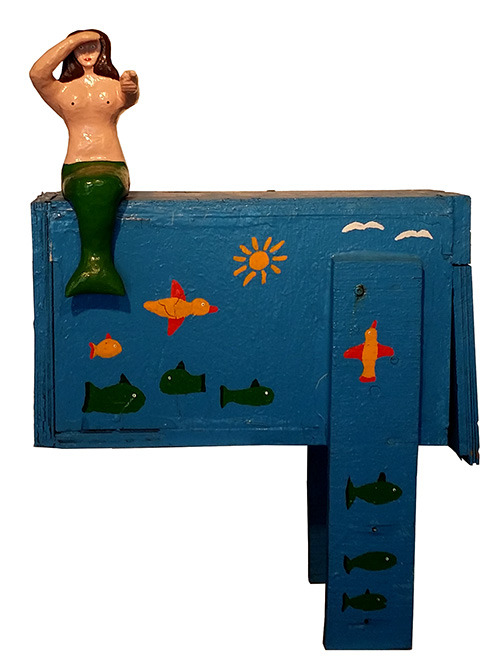
Barry’s solo exhibitions at the Acadia University Art Gallery this summer was a great success, In the words of Laurie Dalton, curator of the exhibition, “This exhibition explores two central themes of the artist’s work: the role of humour and the role of personal biography.” Many of his large carvings and whirligigs from his yard and carving shed were included in the show. Also featured was his mailbox from his former home on West Jeddore Road which is now available at the Black Sheep Gallery. We are also pleased to offer an early blue goose by Barry.
http://www.lighthouse.ca/colpit.html
7 notes
·
View notes
Photo
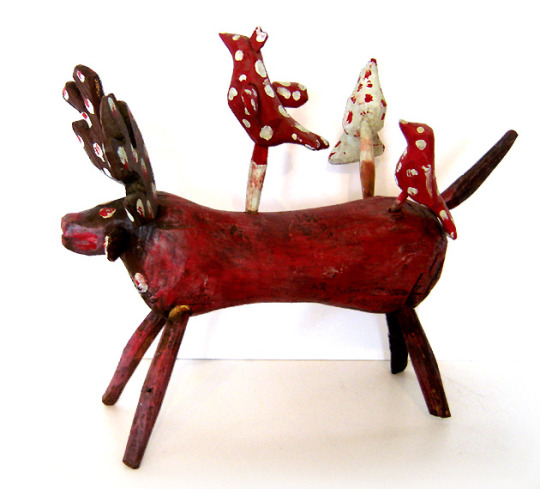
Edmond Chatigny was born in 1895 in St. Isidore de Beauce, Quebec. When he retired as a cattle farmer, he started doing a type of constructive yard art, which employed many little carved additions to a main figure, such as many little birds added to a larger mother bird. He was not interested in selling his work,but rather interested in creating an artistic statement on his terrain, and each year he would have a colour theme for the splatter painted additions to his yard. When he cut his grass it would take two days. One to take everything off the yard, and the next to cut it and put everything back. His sculpture was always nature based, flowers, birds, deer, etc. They were complex assemblages which could be put back together in any number of configurations and still be effective. He continued to carve and decorate his yard, which he turned into a fantasy garden.
“When I was on the farm I used to work hard, then when I retired I had nothing to do and I became bored. That’s what decided me to start making little things - wooden flowers, birds, then all kinds of things. I do it with a little saw and a little knife. Sell them? They are not sellable. They are not made in a minute. It’s all green, white and red with a little brown. This year I think I am going to put a lot of green and white”. Edmond Chatigny died in 1985.
Ref: Kobayashi/Bird, A Compendium of Canadian Folk Artists (1985); Blake McKendry, An Illustrated Companion to Canadian Folk Art (1999), Bernard Riordon (Beaverbrook Gallery), Canadian Folk Art from the Collection of Susan A. Murray (2007); Grosbois, Lamothe, Nantel, Les Patenteux du Quebec (1978); McKendry, Folk Art (1983); Pascale Galipeau, Les Paradis du monde (1995).
http://www.lighthouse.ca/edmond.html
1 note
·
View note
Photo
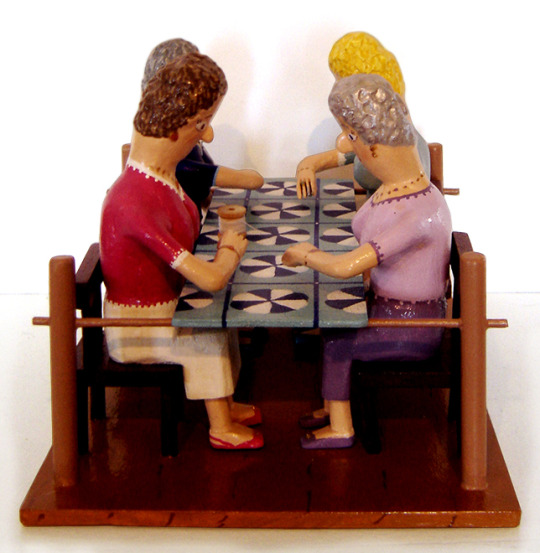
Quilters by Garfield Campbell, a favorite at the Nova Scotia Folk Art Festival.
Garfield Campbell was born on Prince Edward Island, where he grew up on the family farm. In 1939 he enlisted in the army, serving in Britain, Italy and Holland. Upon his return to Canada he worked as a heavy equipment operator until his retirement. At age 65, he married for the first time. Following his retirement, he began woodcarving to pass the time. His art is a link with his experiences and memories of his past, and he has become a favourite of collectors throughout North America. Garfield's carvings are painted by his wife, Verbena. One of Garfield Campbell's carvings was featured on the Nova Scotia Folk Art Festival poster.
http://www.blacksheepart.com/campbell.html
3 notes
·
View notes
Photo
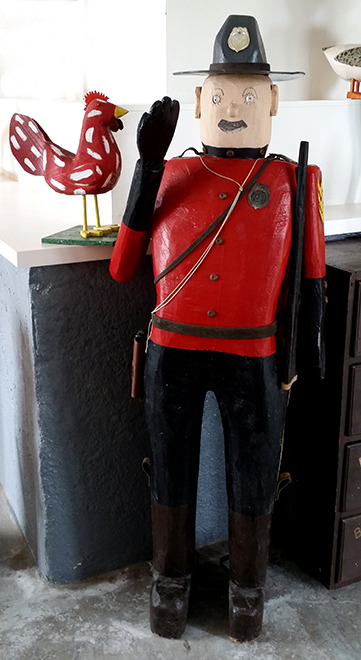
Mountie and rooster by Nova Scotia folk artist Peter Rafuse. Peter is featured on this years Nova Scotia Folk Art Festival poster. You can see a picture of Peter standing beside the Mountie on our site at http://www.lighthouse.ca/rafuse.html. We found the Mountie on a fence post in front of the house owned by well known folk artist Garnet McPhail.
Peter was taught to carve by his neighbor and good friend Garnet McPhail. He has been carving since 1991, and has become popular with collectors throughout Canada and the United States. He carves a variety of subjects including roosters, animals and people, and has participated in several Nova Scotia Folk Art festivals.
Ref: A Joyous Vision - Contemporary Folk Art in Nova Scotia, Nova Scotia Folk Art Festival Society, 1995.
1 note
·
View note
Photo
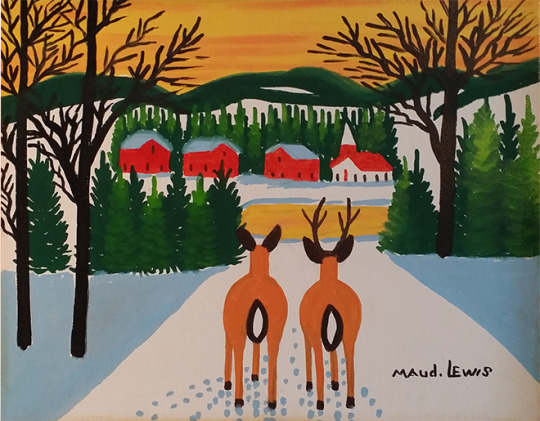
New Maud Lewis painting at the Black Sheep Gallery of two deer in the sunset. This is an unusually large size for Maud at 16" by 20" on canvas board. Maud painted this and two others of similar size for a fiend in the mid 1960s.
http://www.lighthouse.ca/maud.html
2 notes
·
View notes
Photo
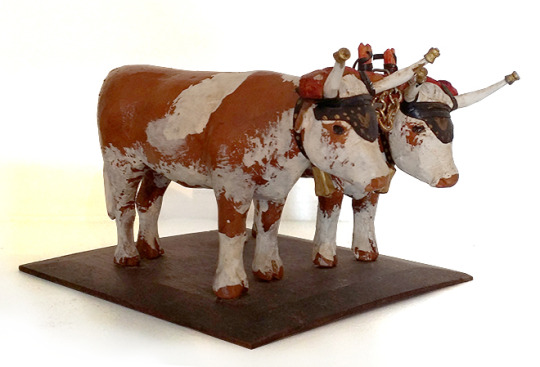
Percy Bezanson lived most of his life in the village of Brickton, Nova Scotia. As a young man, he worked as a log surveyor at a lumber mill, and later he was appointed a county constable, an honorary position he held until age 73. He lived in a small 8 ft. by 10 ft. home with a tiny greenhouse attached to it. Percy said he had whittled all of his life, but following his retirement his output increased. During the fall and winter he concentrated on his carving, and in the spring he planted vegetables in his greenhouse, moving them outside when the warm weather arrived. He carved numerous subjects, but his horses and oxen have become the pieces most sought after by collectors. He also made several banjos and mandolins by hand. He favored old cedar and pine power poles as carving material, and carved using only a jackknife. He claimed there were very few jackknives for the type of work he did, and he was particularly fond of one sent to him by a collector from Germany, and another one sent to him from Japan. Percy stopped carving in 1980 due to a sinus infection. He also had asthma which was irritated by the paint and dust, although he did carve the occassional piece after that when his health permitted. He passed away in 1990 at the age of 84. Ref: "Homestead", March, 1982; The Upper Canadian, May/June, 1994; Blake McKendry, An Illustrated Companion to Canadian Folk Art (1999).
http://www.blacksheepart.com/bezanson6.html
1 note
·
View note